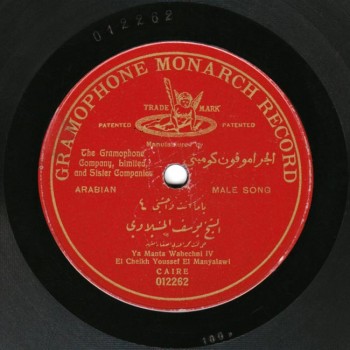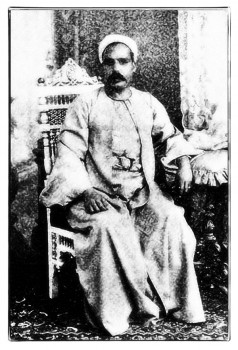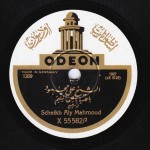The Arab Music Archiving and Research foundation (AMAR), in collaboration with the Sharjah Art Foundation (SAF), presents “Sama‘ ”.
“Sama‘ “ is a show that discusses our musical heritage through comparison and analysis.
A concept by Muṣṭafa Sa‘īd.
Dawr “Yā ma-inta waḥishnī” was written by Sheikh Muḥammad al-Darwīsh and composed by Muḥammad Afandī ‘Uthmān to the ḥijāzkār maqām:
Yā ma-inta waḥishnī we-rūḥī fīk Yā m-ānis albī li-mīn ashkīk
Ashkīk li-illī ādir yihdīk We-yballagh el-ṣābir amaluh
Anā ḥālī fī bu‘dak lam yurḍīk
Kēd el-‘awādhil kāyidnī Bas isma‘ shūf
Inta māliknī min albī We-Allāh bi-el-ma‘rūf
Ḥubbak kawānī ta‘āla shūf Satr el-‘adhūl dāyman makshūf
Anā bi-el-ṣabri ablugh amalī
Yāmā nisma‘ bukra We-ba‘duh nshūf
In this episode we will discuss numerous recordings in a chronological order…
Starting with two recordings by ‘Abd al-Ḥayy Afandī Ḥilmī:
The first recording was made by Odeon around 1905 on three 27cm record sides, order # 45293 1, 2, 3, matrix # EX 1290 a, b, c.
Ḥilmī recorded the dawr again approximately one year later with Zonophone –daughter company of Gramophone– on three sides of a 25cm record, order # X/102958, X/102959, X/102960, matrix # 7814 b, 1/2 b, 1/3 b.
In 1908, Sheikh Yūsuf al-Manyalāwī recorded it with Gramophone on four 30cm record sides, order # 012259, 012260, 012261, 012262, matrix # 97P, 98P, 99P, 100P.
We will also discuss two more recent recordings:
One was made in the mid-1950s. It is a waṣla to the hijāzkār performed by Ṣāliḥ ‘Abd al-Ḥayy, broadcasted and recorded during an Egyptian Radio’s concert.
The other recording is a group performance of this dawr by the Arabic Music Band conducted by ‘Abd al-Ḥalīm Nuwayra.
Let us start the analysis.
Dawr “Yā ma-inta waḥishnī” is among the most revisited adwār I heard. I think it is one of Muḥammad ‘Uthmān’s last adwār, more modern than the ones he composed in the 1930s. This dawr is characterized by its fixed pattern combined with a surprising tolerance for improvisation, variations and initiatives. It could be considered as the “mumasraḥ” (dramatized) dawr par excellence… something midway between a dawr and a theatre play. A theatre play, why? We will discuss this throughout our analysis in today’s episode as well as in next week’s episode of “Sama‘ ”.
Dawr “Yā ma-inta waḥishnī” composed to the hijāzkār maqām is among the very few adwār –maybe the only dawr– displaying the ḥijāzkār maqām as defined in the Arabic and Turkish theory books. In the madhhab, it shifts to the bayyātī 5th scale step, and even though Muḥammad ‘Uthmān and his fellow-composers had composed adwār to the ḥijāzkār maqām before this one, and others who followed also composed adwār to the ḥijāzkār maqām, none of them attempted this shift. Also, the Nahḍa school did not concern itself with the details of the maqāmāt’s melodic structure as it mainly focused on salṭana and ṭarab, putting aside the maqām and its melodic structure.
Let us get acquainted with this maqām and its structure.
This ḥijāz sub-maqām –exactly like the madhhab as written in Sazinda in Turkey and in most Arabic theory books– starts with the kardān then goes down to the rāst through two hijāz scale steps: one 5th scale step and one 1st scale step. Then it goes to a ḥijāz 5th scale step or a nakrīz 4th scale step –but more often a ḥijāz 5th scale step– followed by a bayyātī 5th scale step, and finally goes back to the ḥijāz 1st scale step.
Let us listen to this madhhab’s four versions we have today, with the four performances of ‘Abd al-Ḥayy Afandī Ḥilmī, Sheikh Yūsuf al-Manyalāwī, Ṣāliḥ ‘Abd al-Ḥayy, and the Arabic Music Band conducted by Mr. ‘Abd al-Ḥalīm Nuwayra. Please note that ‘Abd al-Ḥayy Ḥilmī’s recording we will listen to now is the one made by Odeon, not the one made by Zonophone.
Anyway, the madhhab is almost the same in the two recordings.
Listening to the madhhab will show that ‘Abd al-Ḥayy and Sheikh Yūsuf both sing it to the same octave almost.
While Ṣāliḥ ‘Abd al-Ḥayy sings it two tones lower, maybe because of his age, or because he wanted to rest during the répons. The Arabic Music Band sings it lower than Ṣāliḥ ‘Abd al-Ḥayy by half a tone, i.e. lower than Sheikh Yūsuf and ‘Abd al- Ḥayy by a full quartertone, probably taking into account the female singers’ voices.
One last comment on the maqām concerning the lyrics:
Both Sheikh Yūsuf and ‘Abd al-Ḥayy say “Anā ḥālī we-bu‘dak lam yurḍīk”, which is compatible with the lyrics in the books.
While Ṣāliḥ ‘Abd al-Ḥayy and all those who followed say “Anā ḥālī fī bu‘dak lam yurḍīk”.
In both cases, the meaning is relevant, yet we do not know the secret behind this change.
Let us listen to the four recordings and note how each of these four singers deals with the madhhab.
(♩)
As we have heard, the melody is almost the same except for a few individual variations by each of the three. The fourth piece is obviously a fixed melody because it is sang by a group that is a choir, not a biṭāna. This is important: the three previous recordings include a biṭāna that deals with the melody exactly like the muṭrib. While the purpose of the fourth recording –the group recording– is the setting of the melody, to confirm that it was written to be sang this way, and allows zero individual initiatives.
Let us go now to the phrase that comes right after the madhhab and introduces the tafrīd. It is taken from the madhhab or composed to the dawr’s maqām, and introduces the tafrīd by telling the mufrid what to do.
Let us listen to this phrase performed by ‘Abd al-Ḥayy, by Sheikh Yūsuf, and finally by Ṣāliḥ.
We will listen to ‘Abd al-Ḥayy in the recording made by Odeon.
There is no need to listen to ‘Abd al-Halīm Nuwayra’s band’s interpretation because they performed this phrase following a fixed pattern, close to Sheikh Yūsuf al-Manyalāwī’s interpretation for example.
Before listening to ‘Abd al-Ḥayy’s recording –which is the first one we will listen to–, we will listen to the instrumental interpretation of the madhhab. They play the madhhab as it is. In general, instrumental music is very present in playing and performing adwār and in the performance of Arabic Classical Music –or Arabic Literary Music as I like to call it.
Let us listen to the three phrases interpreted by the three performers.
(♩)
There is an essential remark here:
The instrumental interpretation is present in ‘Abd al-Ḥayy Afandī’s as well as in Sheikh Yūsuf’s performance, whether in the madhhab or in the tafrīd.
Whereas in Ṣāliḥ ‘Abd al-Ḥayy’s recording made no less than 45 years after Sheikh Yūsuf al-Manyalāwī’s recording, there is no trace of interpretation, only a measure on the maqām’s position.
This remark, among other proofs, shows that the role of instrumental music starting the 1950s became limited. It was limited because instrumental music starting then became only in the service of pop stars. Even if Ṣāliḥ ‘Abd al-Ḥayy refused this and insisted on interpretation, the musicians were now unaccustomed to interpret, only used to serve the work of the muṭrib.
Ṣāliḥ ‘Abd al-Ḥayy was very much influenced by his uncle ‘Abd al-Ḥayy Ḥilmī in his performance of this phrase: a quasi-set and quasi-improvised phrase with which each dealt at whim, extending it or shortening it… as long as the final goal of salṭana before the tafrīd was reached.
Ṣāliḥ ‘Abd al-Ḥayy had surely heard Sheikh Yūsuf al-Manyalāwī’s performance. He may even have heard him live face to face, not only through the recording. Yet, the influence of his uncle ‘Abd al- Ḥayy Ḥilmī is stronger. Actually, he is probably the one accompanying him as a biṭāna in the Odeon recording we already listened to, as well as in the Zonophone recording we will listen to later on.
The tafrīd section must be followed by the dialogue section with the biṭāna that must include henk or tarannum followed by the waḥāyid i.e. the dialogue with the lyrics of the dawr. The “dramatization” of the dawr becomes very obvious here: Muḥammad ‘Uthmān allowed the performer to place the tarannum at whim, yet he wrote for him a compulsory bayyātī shift. Consequently, will the tarannum be to the bayyātī or to the hijāzkār followed by a shift to the bayyātī? Then he placed for him a dialogue with the biṭāna… How do people deal with such issues?
Let us listen to this shift to the bayyātī performed by ‘Abd al-Ḥayy Ḥilmī in both the Odeon and the Zonophone recordings, then performed by Sheikh Yūsuf in his recording made by Gramophone.
We will notice that ‘Abd al-Ḥayy Ḥilmī, in the first recording made by Odeon, exploits the technology and the turning of the record from the second side to the third side in order to shift to the bayyātī.
In the Zonophone recording made around one year later, ‘Abd al-Ḥayy is the one who leads the band to the bayyātī.
Whereas Sheikh Yūsuf is led to the bayyātī by the band. It seems that he gives them a signal during the tafrīd for them to lead the shift to the bayyātī.
We will discuss Ṣāliḥ ‘Abd al-Ḥayy’s recording later, maybe in the next episode.
Let us now listen to these three shifts and note the different ways in which they are conducted from the origin to the maqām’s 5th scale step that will lead to the bayyātī and later to the ṣabā.
Let us listen.
(♩)
Let us put a pause to our analysis and conclude today’s episode with a complete recording of the dawr performed by ‘Abd al-Ḥayy Ḥilmī and made by Zonophone.
The first thing we will notice is that he concludes the dawr to a melody that is different from the dawr’s: he starts the dawr to the hijāzkār and concludes it to the hijāzkār 5th scale step i.e. the ṣabā after the bayyātī. Even though he will shift to the jahārkāh, the jahārkāh 7th scale step, knowing that the jahārkāh 7th scale step is not at all from the origin of the maqām. It bears no relation to the pattern of the hijāzkār maqām. Thus our deduction concerning the “dramatization” in this issue, the compulsory expression.
Anyway, ‘Abd al-Ḥayy in the Odeon recording does not sing to the jahārkāh at all. We will explain this in detail in the next episode.
So, ‘Abd al-Ḥayy Ḥilmī shortens and extends at whim within the pattern of the dawr. He does not abide at all by the dawr’s pattern, even though he does abide by the “dramatization” of the dawr. His dialogue with the biṭāna is limited to and by the jahārkāh as well as the conclusion at the end of the dawr.
Besides that, he sings it almost individually, except for the madhhab and the part we talked about previously.
The dawr starts with taqāsīm by Ibrāhīm Sahlūn’s kamān, followed by layālī and a dūlāb, then he sings the dawr and concludes to the hijāzkār 5th scale step i.e. the ṣabā, in a very very very decisive manner.
Talking about Ibrāhīm Sahlūn, we must highlight the strange tuning of his kamān here: two 5th scale steps and one 4th scale step, Fa Do Sol Do for the experts. This tuning is mentioned in some old books such as Al-Khula‘ī’s book. We also heard it performed by old musicians such as Sāmī al-Shawwā for example, especially in his last recordings. But this tuning is not the norm nowadays. I think this adds a new point of reference concerning the fact that all instruments were tuned according to the maqām, not only the qānūn.
Let us listen to dawr “Yā ma-inta waḥishnī” written by Sheikh Muḥammad al-Darwīsh and composed by Muḥammad ‘Uthmān, performed by ‘Abd al-Ḥayy Afandī Ḥilmī. The recording was made by Zonophone.
With it, we will end today’s episode of “Sama‘ ”.
We will meet again in a new episode to resume our analysis of dawr “Yā ma-inta waḥishnī”
Now let us listen to ‘Abd al-Ḥayy Afandī.
(♩)
“Sama‘ ” is brought to you by AMAR.
- 221 – Zakariyya Ahmed – 12 (1/9/2022)
- 220 – Zakariyya Ahmed – 11 (1/9/2022)
- 219 – Zakariyya Ahmed – 10 (11/25/2021)
- 218 – Zakariyya Ahmed – 9 (10/26/2021)
- 217 – Zakariyya Ahmed – 8 (9/24/2021)
- 216 – Zakariyya Ahmed – 7 (9/4/2021)
- 215 – Zakariyya Ahmed – 6 (8/28/2021)
- 214 – Zakariyya Ahmed – 5 (8/6/2021)
- 213 – Zakariyya Ahmed – 4 (6/26/2021)
- 212 – Zakariyya Ahmed – 3 (5/27/2021)
- 211 – Zakariyya Ahmed – 2 (5/1/2021)
- 210 – Zakariyya Ahmed – 1 (4/28/2021)
- 209 – W-al-Lāhi lā astaṭī‘u ṣaddak 2 (4/6/2017)
- 208 – W-al-Lāhi lā astaṭī‘u ṣaddak 1 (3/30/2017)
- 207 – Bashraf qarah baṭāq 7 (3/23/2017)





